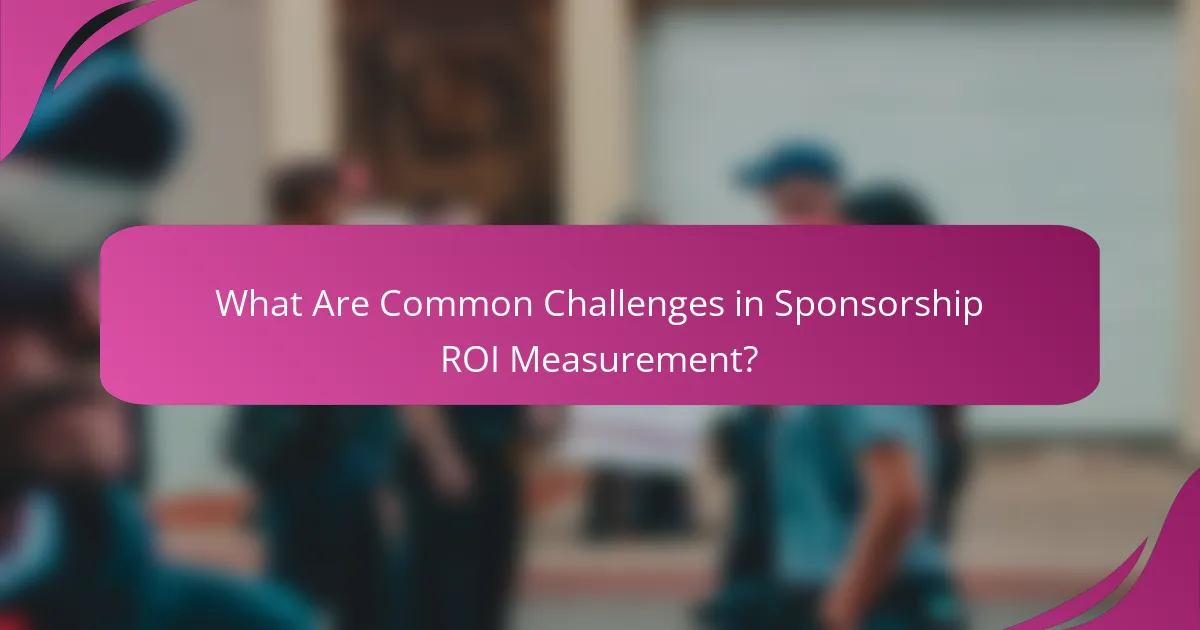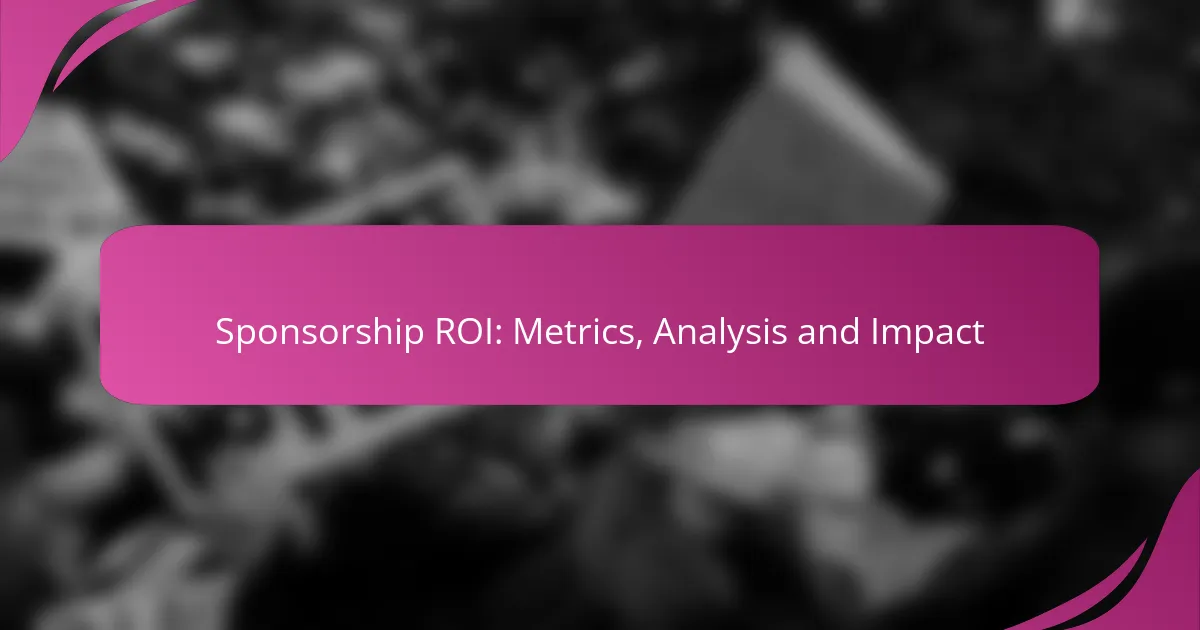Understanding sponsorship ROI is crucial for organizations seeking to maximize the value of their investments. By analyzing key metrics such as financial returns, brand awareness, and audience engagement, businesses can assess the effectiveness of their sponsorships and make informed decisions for future partnerships. Implementing effective analysis techniques and focusing on measurable engagement can significantly enhance the overall impact of sponsorship initiatives.

How to Measure Sponsorship ROI?
Measuring sponsorship ROI involves evaluating the effectiveness of a sponsorship investment by analyzing various metrics that reflect its impact on business goals. Key areas to focus on include financial returns, brand awareness, audience engagement, and customer acquisition costs.
Key performance indicators (KPIs)
KPIs are essential for assessing the success of a sponsorship. Common KPIs include reach, impressions, and conversion rates, which provide insights into how well the sponsorship is performing against set objectives. Establishing clear KPIs before the sponsorship begins allows for more accurate measurement and analysis later on.
When selecting KPIs, consider aligning them with your overall marketing goals. For example, if the goal is to increase brand visibility, focus on metrics like social media mentions and website traffic generated from the sponsorship.
Financial metrics
Financial metrics are critical for quantifying the monetary impact of a sponsorship. These may include direct revenue generated from sponsorship-related sales, as well as cost savings from increased brand loyalty. Calculating the return on investment (ROI) can be done by comparing the total revenue generated against the total costs incurred.
To evaluate financial metrics effectively, track sales data before, during, and after the sponsorship period. This will help identify trends and determine the sponsorship’s contribution to overall revenue growth.
Brand awareness metrics
Brand awareness metrics gauge how well your brand is recognized in the market due to the sponsorship. Common methods to measure this include surveys, social media engagement, and website traffic analytics. These metrics help determine if the sponsorship has successfully increased visibility among the target audience.
Consider conducting pre- and post-sponsorship surveys to assess changes in brand recognition. A notable increase in brand recall or positive sentiment can indicate a successful sponsorship effort.
Engagement metrics
Engagement metrics assess how actively audiences interact with your brand during and after the sponsorship. This includes social media interactions, event attendance, and content shares. High engagement levels often correlate with a successful sponsorship, as they indicate that the audience is connecting with your brand.
To measure engagement, utilize tools that track social media analytics and website interactions. Look for patterns in audience behavior, such as increased comments or shares during sponsorship events, to evaluate effectiveness.
Customer acquisition cost
Customer acquisition cost (CAC) measures the total expense involved in acquiring a new customer through sponsorship efforts. This includes costs related to marketing, promotions, and any direct expenses tied to the sponsorship. Understanding CAC helps determine if the sponsorship is a cost-effective means of gaining new customers.
To calculate CAC, divide the total sponsorship costs by the number of new customers acquired during the sponsorship period. A lower CAC indicates a more efficient sponsorship, while a higher CAC may signal the need for strategic adjustments in future sponsorships.

What Are Effective Sponsorship ROI Analysis Techniques?
Effective sponsorship ROI analysis techniques focus on measuring the impact and value derived from sponsorship investments. These methods help organizations understand the effectiveness of their sponsorships and guide future decisions.
Comparative analysis
Comparative analysis involves evaluating the performance of different sponsorships against each other or against industry benchmarks. This technique allows organizations to identify which sponsorships yield the highest returns and why. For example, comparing metrics such as brand awareness, engagement rates, and sales lift can reveal which partnerships are most effective.
When conducting a comparative analysis, consider factors like audience demographics and market conditions. This context can significantly influence results and help to draw more accurate conclusions. Always ensure that comparisons are made between similar types of sponsorships to maintain relevance.
Attribution modeling
Attribution modeling assigns value to different touchpoints in the customer journey that contribute to a conversion. In sponsorships, this means understanding how various sponsorship activities impact consumer behavior and decision-making. For instance, a multi-touch attribution model can help determine how much credit to assign to a sponsorship event versus digital ads.
Choose an attribution model that aligns with your goals, whether it’s first-touch, last-touch, or a more complex multi-touch approach. Be aware that the choice of model can significantly affect the perceived ROI, so selecting the right one is crucial for accurate analysis.
Surveys and feedback
Surveys and feedback are direct methods to gauge the effectiveness of sponsorships from the audience’s perspective. Collecting data through post-event surveys can provide insights into brand perception, recall, and overall satisfaction with the sponsorship experience. This qualitative data complements quantitative metrics and can highlight areas for improvement.
When designing surveys, keep questions concise and focused on specific sponsorship elements. Consider using a mix of rating scales and open-ended questions to gather comprehensive feedback. Regularly analyzing this data can help refine future sponsorship strategies and enhance overall ROI.

How to Improve Sponsorship ROI?
Improving sponsorship ROI involves focusing on measurable engagement, aligning with strategic partners, and integrating effective content marketing. By optimizing these areas, organizations can enhance the value derived from their sponsorship investments.
Targeted audience engagement
Targeted audience engagement is crucial for maximizing sponsorship ROI. Understanding the demographics and preferences of your audience allows for tailored messaging and interactions that resonate. Utilize surveys, social media insights, and event feedback to refine your approach.
Consider employing tools like audience segmentation to identify key groups within your target market. This can lead to more personalized experiences, which often result in higher engagement rates and increased brand loyalty.
Strategic partnership alignment
Aligning with strategic partners can significantly boost sponsorship ROI. Seek partnerships that complement your brand values and objectives, ensuring mutual benefits. This alignment can enhance credibility and expand reach within your target market.
Evaluate potential partners based on their audience demographics, market presence, and reputation. A well-chosen partnership can lead to co-branded campaigns that leverage both parties’ strengths, ultimately driving better results.
Content marketing integration
Integrating content marketing into your sponsorship strategy is essential for enhancing ROI. Create compelling content that highlights the sponsorship and engages your audience across multiple platforms. This can include blog posts, videos, and social media content that tell a cohesive story.
Utilize a content calendar to plan and execute your marketing efforts effectively. Regularly assess the performance of your content to identify what resonates best with your audience, allowing for continuous improvement and adaptation of your strategy.

What Are Common Challenges in Sponsorship ROI Measurement?
Measuring the return on investment (ROI) for sponsorships can be complex due to various challenges that organizations face. These challenges often stem from data collection, attribution, and the use of inconsistent metrics, which can obscure the true impact of sponsorship efforts.
Data collection issues
Data collection is a critical aspect of measuring sponsorship ROI, yet it often presents significant challenges. Organizations may struggle with gathering comprehensive data from multiple sources, such as social media, event attendance, and sales figures. Inconsistent data formats and lack of integration between systems can further complicate the process.
To improve data collection, establish clear guidelines on what data to collect and how to standardize it across platforms. Utilizing tools that automate data gathering can also streamline the process and enhance accuracy.
Attribution difficulties
Attributing specific outcomes to sponsorship activities can be particularly challenging. Many factors influence consumer behavior, making it hard to isolate the impact of a sponsorship from other marketing efforts. This can lead to overestimating or underestimating the effectiveness of a sponsorship.
To address attribution difficulties, consider using multi-touch attribution models that account for various customer interactions. This approach can provide a more nuanced understanding of how sponsorships contribute to overall marketing success.
Inconsistent metrics
Inconsistent metrics across different sponsorships can hinder effective ROI measurement. Organizations may use various metrics to evaluate success, such as brand awareness, engagement, or sales, leading to confusion and misalignment in goals.
Establishing a standardized set of metrics for all sponsorships can help ensure consistency. Focus on key performance indicators (KPIs) that align with overall business objectives, and regularly review these metrics to adapt to changing market conditions.

What Tools Can Help Analyze Sponsorship ROI?
Analyzing sponsorship ROI requires a combination of tools that can track performance metrics and provide insights into the effectiveness of sponsorship investments. Key tools include analytics software, social media monitoring platforms, and customer relationship management (CRM) systems.
Analytics Software
Analytics software is essential for measuring the impact of sponsorships on brand awareness and engagement. These tools can track website traffic, conversion rates, and user behavior, providing valuable data on how sponsorships influence customer interactions. Popular options include Google Analytics and Adobe Analytics, which offer customizable dashboards for real-time insights.
When selecting analytics software, consider integration capabilities with existing systems and the specific metrics that matter most to your sponsorship goals. Look for features that allow you to segment data by demographics or campaign performance for deeper analysis.
Social Media Monitoring Platforms
Social media monitoring platforms help assess the reach and sentiment of sponsorship campaigns across various social channels. Tools like Hootsuite and Sprout Social can track mentions, engagement rates, and audience growth, providing a comprehensive view of how sponsorships resonate with target audiences.
Utilizing these platforms effectively involves setting up alerts for brand mentions and analyzing engagement trends over time. This can help identify which sponsorships generate the most buzz and inform future marketing strategies.
Customer Relationship Management (CRM) Systems
CRM systems play a crucial role in tracking customer interactions and measuring the long-term impact of sponsorships on sales and loyalty. By integrating sponsorship data with customer profiles, businesses can analyze how sponsorships influence purchasing decisions and customer retention.
When using a CRM for sponsorship analysis, ensure that you capture relevant data points such as customer feedback and purchase history related to sponsorship campaigns. This will allow for more accurate assessments of ROI and help tailor future sponsorship efforts to better meet customer needs.
